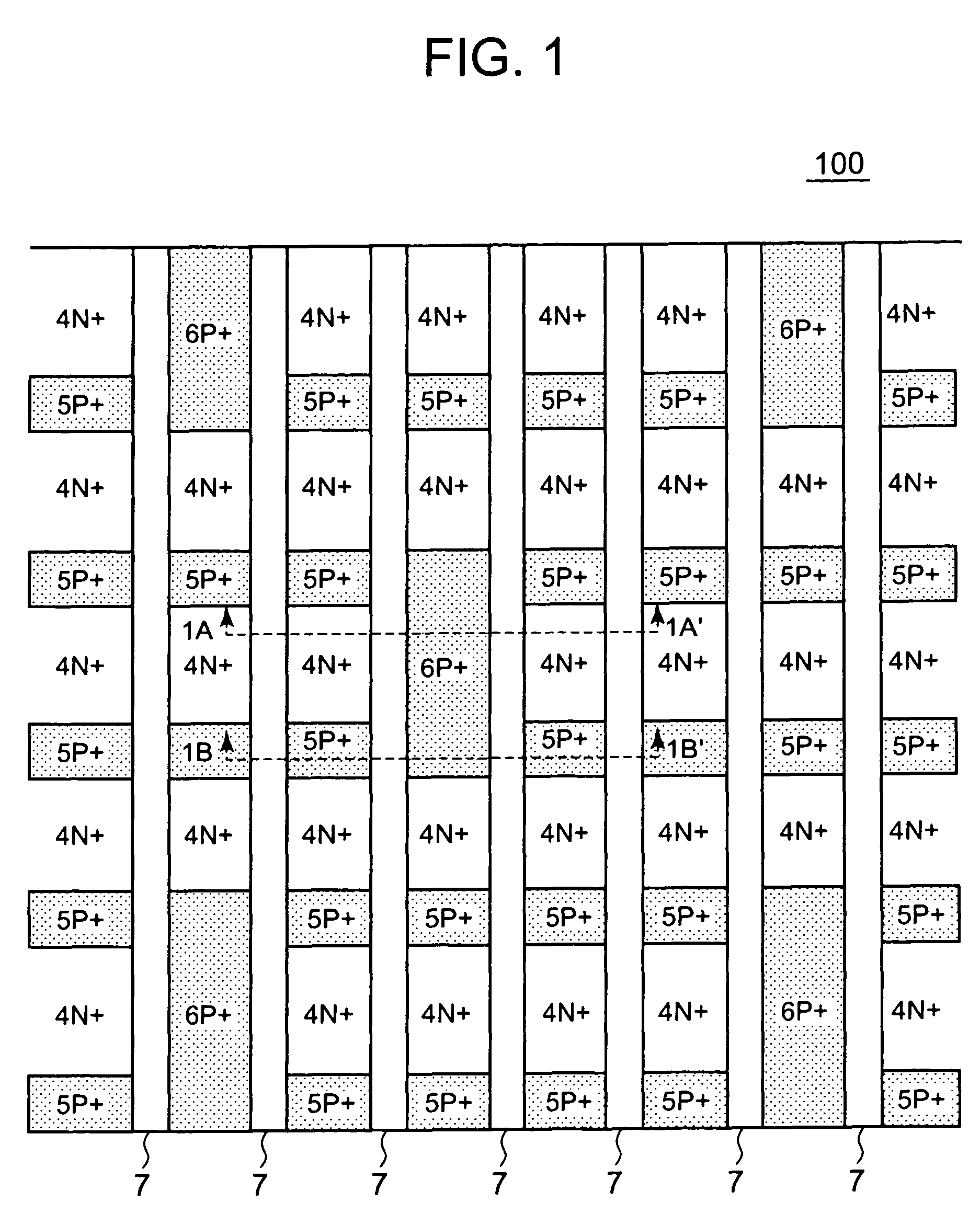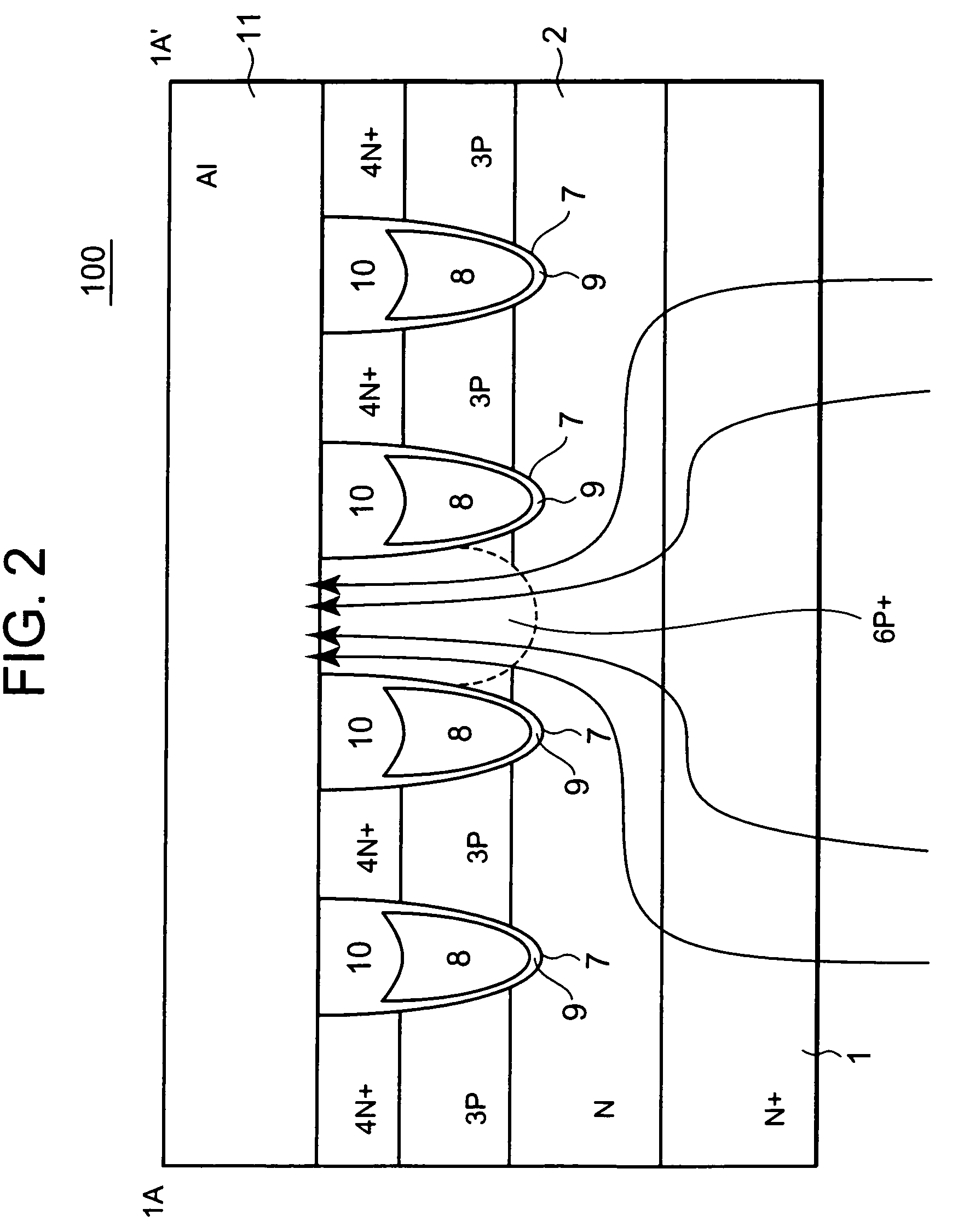Semiconductor device having trench gate structure
a technology of semiconductor devices and gate structures, which is applied in the direction of semiconductor devices, diodes, electrical devices, etc., can solve the problems of difficult integration and worsening of ions
- Summary
- Abstract
- Description
- Claims
- Application Information
AI Technical Summary
Benefits of technology
Problems solved by technology
Method used
Image
Examples
first embodiment
[0035]Construction of a semiconductor device according to a first embodiment of the present invention will be described with reference to FIG. 1 to FIG. 3. FIG. 1 is a schematic plan view showing planar structure of an N channel type vertical MOSFET 100 which is an example of the semiconductor device according to the first embodiment. FIG. 2 is a schematic sectional view taken along line 1A-1A′ of FIG. 1. FIG. 3 is a schematic sectional view taken along line 1B-1B′ of FIG. 1.
[0036]As shown in FIG. 1, the vertical MOSFET 100 has gate trenches 7 arranged in stripes. A plurality of gate trenches 7 are formed in a MOSFET cell region. In addition, these gate trenches 7 may be connected mutually in a peripheral region and become a single trench. In addition, the plurality of gate trenches 7 may not be connected mutually even in a peripheral region and remain being plural.
[0037]Between the gate trenches 7, N+ source regions 4N+ and P+ base contact regions 5P+ are formed. The N+ source regi...
second embodiment
[0049]Construction of a semiconductor device according to a second embodiment of the present invention will be described with reference to FIG. 4. FIG. 4 is a schematic plan view showing planar structure of an N channel type vertical MOSFET 110 which is an example of the semiconductor device according to the second embodiment. In the vertical MOSFET 110, a different point from the vertical MOSFET 100 shown in FIG. 1 is a formation position of a diode region (anode region 6P+). In addition, in FIG. 4, the same reference numerals are assigned to the same components as those in FIGS. 1 to 3, and their descriptions are omitted.
[0050]In the vertical MOSFET 100, a diode region (anode region 6P+) is formed in a part of arbitrary two P+ base contact regions 5P+ and one N+ source region 4N+ sandwiched between the two adjacent P+ base contact regions 5P+. In the vertical MOSFET 110, the diode region (anode region 6P+) is formed so as to stride one P+ base contact region 5P+.
[0051]Specifically...
third embodiment
[0054]Construction of a semiconductor device according to a third embodiment of the present invention will be described with reference to FIG. 5. FIG. 5 is a schematic plan view showing planar structure of an N channel type vertical MOSFET 120 which is an example of the semiconductor device according to the third embodiment. In the vertical MOSFET 120, a different point from the vertical MOSFET 100 shown in FIG. 1 is a formation position of a diode region (anode region 6P+). In addition, in FIG. 5, the same reference numerals are assigned to the same components as those in FIGS. 1 to 3, and their descriptions are omitted.
[0055]As shown in FIG. 5, in the vertical MOSFET 120, a diode region (anode region 6P+) is formed between arbitrary two adjacent gate trenches 7. In other words, all of the N+ source region 4N+ and the P+ base contact region 5p+ of an arbitrary array are replaced with a single anode region 6P+.
[0056]Specifically, as shown in FIG. 5, the vertical MOSFET 120 has the g...
PUM
 Login to View More
Login to View More Abstract
Description
Claims
Application Information
 Login to View More
Login to View More - R&D
- Intellectual Property
- Life Sciences
- Materials
- Tech Scout
- Unparalleled Data Quality
- Higher Quality Content
- 60% Fewer Hallucinations
Browse by: Latest US Patents, China's latest patents, Technical Efficacy Thesaurus, Application Domain, Technology Topic, Popular Technical Reports.
© 2025 PatSnap. All rights reserved.Legal|Privacy policy|Modern Slavery Act Transparency Statement|Sitemap|About US| Contact US: help@patsnap.com



